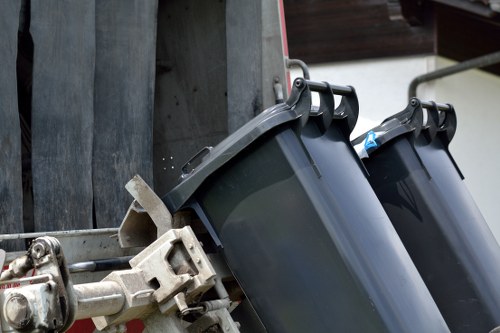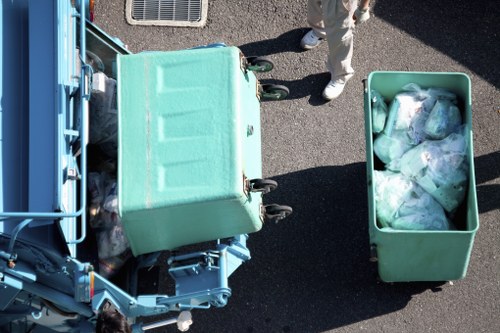Large Item Collection in Waste Recycling
Introduction to Large Item Collection

In today's world, effective waste management is crucial for maintaining a healthy environment. Among the various aspects of waste management, large item collection plays a significant role in ensuring that bulky waste is handled responsibly and sustainably. Large items, often referred to as bulk waste, include furniture, appliances, electronics, and other sizable household or commercial products that are typically challenging to dispose of through regular waste collection methods.
The process of collecting large items involves specialized services that are equipped to handle the transportation and recycling of these bulky goods. By focusing on large item collection, communities can significantly reduce the amount of waste that ends up in landfills, promoting a more sustainable approach to waste management.
Furthermore, large item collection contributes to the economy by supporting recycling industries and creating job opportunities. As consumers become more aware of their environmental impact, the demand for efficient large item recycling services continues to grow, making it an essential component of modern waste management systems.
The Importance of Recycling Large Items

Recycling large items is vital for several reasons. Firstly, it helps in conserving natural resources by reusing materials that would otherwise be discarded. For instance, recycling old furniture can recover valuable materials like wood, metal, and plastic, which can be repurposed into new products. This not only reduces the need for virgin resources but also minimizes the environmental footprint of manufacturing processes.
Secondly, recycling large items significantly reduces greenhouse gas emissions. When bulky waste decomposes in landfills, it generates methane, a potent greenhouse gas that contributes to climate change. By diverting these items from landfills and processing them through recycling facilities, we can mitigate the release of harmful emissions.
Additionally, effective large item recycling supports energy conservation. Manufacturing new products from recycled materials typically requires less energy compared to producing them from raw resources. This energy efficiency translates into lower operational costs and a reduced impact on the environment.
Types of Large Items Collected

Large item collection encompasses a wide range of products, each requiring specific handling and recycling processes. Some common types of large items include:
- Furniture: Items such as sofas, mattresses, tables, and chairs are commonly collected for recycling.
- Appliances: Large appliances like refrigerators, washing machines, dryers, and ovens are frequently part of bulk waste collections.
- Electronics: Televisions, computers, and other electronic devices are collected to prevent the release of hazardous materials and to recover valuable components.
- Construction Materials: Items like old windows, doors, and roofing materials are also included in large item collections.
- Office Equipment: Desks, filing cabinets, and other office furnishings are collected for recycling and repurposing.
Each category of large items requires tailored recycling strategies to maximize material recovery and minimize environmental impact. Specialized facilities are equipped to handle the disassembly, sorting, and processing of these bulky goods to ensure they are recycled efficiently and effectively.
The Collection Process

The large item collection process involves several key steps to ensure the efficient handling and recycling of bulky waste. Understanding this process can help consumers and businesses better manage their waste and contribute to environmental sustainability.
1. Scheduling and Pickup
The first step in large item collection is scheduling a pickup with a waste management service provider. This typically involves booking a specific date and time for the collection, ensuring that the service is convenient for the customer. Many providers offer online booking systems, making it easy to arrange pickups without the need for lengthy phone calls.
During the scheduling process, customers may be required to specify the type and number of large items they wish to dispose of. This information helps service providers allocate the appropriate resources and ensure that the necessary equipment, such as large trucks or specialized containers, is available for the pickup.
2. Collection and Transportation
Once the pickup is scheduled, the waste management team arrives at the designated location to collect the large items. The collection process involves careful handling to prevent damage to the items or the surrounding property. In some cases, the team may need to disassemble bulky items or move them from a storage area to the collection truck.
Transportation of large items requires specialized vehicles that can accommodate the size and weight of the waste. Proper transportation is crucial to ensure that the items reach recycling facilities safely and without causing any disruption to public spaces or private properties.
3. Sorting and Processing
After transportation, large items are taken to recycling facilities where they undergo sorting and processing. This stage involves categorizing items based on their material composition, such as wood, metal, plastic, or electronic components. Advanced sorting technologies, including automated systems and manual labor, are employed to ensure accurate separation of materials.
Processed materials are then prepared for recycling or repurposing. For example, metals may be melted down and reused in manufacturing new products, while plastics can be shredded and reformed into new materials. Electronics are carefully dismantled to recover valuable components and prevent the release of hazardous substances.
Benefits of Proper Large Item Recycling

Engaging in proper large item recycling offers numerous benefits that extend beyond environmental conservation. Here are some of the key advantages:
Environmental Benefits
Recycling large items reduces the volume of waste sent to landfills, thereby conserving space and minimizing environmental pollution. It also lowers greenhouse gas emissions by decreasing the need for new materials and reducing energy consumption in manufacturing processes.
Economic Advantages
Recycling initiatives create economic opportunities by generating jobs in the collection, sorting, processing, and manufacturing sectors. Additionally, the reuse of materials can lead to cost savings for manufacturers, which can be passed on to consumers through lower prices.
Social Impact
Proper large item recycling fosters a culture of sustainability and responsibility within communities. It encourages individuals and businesses to adopt environmentally friendly practices, contributing to the overall well-being and health of society.
Resource Conservation
By recycling large items, valuable resources such as metals, plastics, and wood are conserved and kept in the production cycle. This reduces the reliance on finite resources and supports the development of a circular economy.
Challenges and Solutions in Large Item Collection

While large item collection is essential for waste management, it comes with its own set of challenges. Understanding these challenges and implementing effective solutions can enhance the efficiency and effectiveness of recycling programs.
1. Logistical Issues
Collecting large items often requires specialized vehicles and equipment, which can be a logistical challenge, especially in densely populated urban areas. To address this, waste management companies can invest in versatile fleets and optimize collection routes to maximize efficiency.
2. Consumer Awareness
Many consumers are unaware of the proper procedures for large item disposal and recycling. Educational campaigns and clear communication from service providers can help increase awareness and encourage participation in recycling programs.
3. Cost Management
Providing large item collection services can be costly due to the need for specialized resources. Implementing cost-effective strategies, such as bundling services or offering tiered pricing, can help manage expenses while maintaining service quality.
4. Regulatory Compliance
Adhering to environmental regulations and standards is crucial for large item recycling operations. Staying informed about regulatory changes and investing in compliance training for staff can ensure that recycling practices meet legal requirements.
Future Trends in Large Item Recycling

The landscape of large item recycling is continually evolving, driven by advancements in technology and increasing environmental awareness. Here are some emerging trends shaping the future of large item collection and recycling:
- Smart Recycling Systems: The integration of IoT (Internet of Things) technology enables real-time tracking and efficient management of large item collection processes.
- Automated Sorting: Automation and robotics are being utilized to enhance the sorting and processing of large items, improving accuracy and reducing labor costs.
- Extended Producer Responsibility (EPR): Manufacturers are increasingly held accountable for the end-of-life management of their products, promoting the design of recyclable and sustainable products.
- Circular Economy Models: Emphasizing the reuse and repurposing of materials, circular economy models aim to create a closed-loop system that minimizes waste and maximizes resource efficiency.
- Community Recycling Initiatives: Local communities are taking proactive roles in large item recycling through organized collection drives and collaborative efforts with recycling facilities.
These trends indicate a positive trajectory towards more efficient and sustainable large item recycling practices, ensuring that bulky waste is managed responsibly and contributes to environmental preservation.
How to Participate in Large Item Recycling
For Homeowners
Homeowners can actively participate in large item recycling by following these simple steps:
- Identify Items for Recycling: Assess your home for large items that are no longer needed or functional, such as old furniture, appliances, or electronics.
- Schedule a Pickup: Contact a local waste management service to arrange for the collection of your large items. Ensure you provide accurate details about the items to facilitate smooth pickup.
- Prepare Items for Collection: Clear the items from your living spaces and place them in a designated area for easy access by the collection team.
- Ensure Accessibility: Make sure that the collection team can easily access the items, especially if they are located on upper floors or in hard-to-reach areas.
- Stay Informed: Keep abreast of local recycling regulations and guidelines to ensure that your disposal practices align with community standards.
For Businesses
Businesses also play a crucial role in large item recycling. Here are some steps businesses can take:
- Conduct Waste Audits: Regularly review your waste output to identify opportunities for reducing, reusing, and recycling large items.
- Partner with Recycling Services: Collaborate with professional recycling companies to manage your bulky waste effectively.
- Implement Sustainable Practices: Encourage the use of durable and recyclable materials in your business operations to minimize future waste.
- Educate Employees: Train your staff on proper waste disposal and recycling procedures to foster a culture of sustainability within your organization.
- Track Recycling Efforts: Monitor and report on your recycling activities to measure progress and identify areas for improvement.
By taking these proactive steps, businesses can contribute significantly to large item recycling initiatives and support overall environmental sustainability.
Choosing the Right Recycling Service
Factors to Consider
Selecting an appropriate recycling service for large item collection involves evaluating several critical factors to ensure reliability and efficiency:
- Reputation: Research the service provider's reputation by reading reviews and testimonials to gauge their reliability and customer satisfaction.
- Services Offered: Ensure that the provider offers comprehensive services tailored to your specific large item recycling needs, including pickup, transport, and processing.
- Pricing: Compare pricing structures of different providers to find a service that fits your budget while maintaining quality.
- Environmental Standards: Verify that the recycling service adheres to environmental regulations and employs sustainable practices in their operations.
- Availability: Check the service provider's availability to schedule pickups at convenient times that align with your requirements.
- Customer Support: Opt for providers that offer excellent customer support to address any queries or issues promptly.
Questions to Ask Potential Providers
To make an informed decision, consider asking the following questions when evaluating potential large item recycling services:
- What types of large items do you collect and recycle?
- How do you ensure that collected items are recycled responsibly?
- What are your pricing options for large item collection services?
- Do you offer any additional services, such as disassembly or on-site consultations?
- What is your policy on data security for electronic waste?
- Can you provide references or case studies from previous clients?
Asking these questions helps you assess whether a recycling service aligns with your needs and environmental values, ensuring a successful partnership in managing large item waste.
Case Studies: Successful Large Item Recycling Programs
Examining successful large item recycling programs offers valuable insights into effective waste management strategies. Here are two notable examples:
1. Green Earth Initiative
The Green Earth Initiative implemented a comprehensive large item recycling program in a mid-sized city, focusing on community engagement and sustainable practices. Key elements of their program included:
- Community Outreach: Conducting educational workshops and awareness campaigns to inform residents about the benefits of large item recycling.
- Scheduled Collection Days: Establishing regular collection days specifically for bulky waste, ensuring consistent and reliable service.
- Partnerships: Collaborating with local businesses and recycling facilities to streamline the recycling process and enhance material recovery rates.
- Incentive Programs: Offering incentives, such as discounts on utility bills, to encourage participation in recycling programs.
As a result of these efforts, the Green Earth Initiative achieved a significant reduction in landfill waste and fostered a culture of sustainability within the community.
2. EcoCycle Solutions
EcoCycle Solutions, a nationwide waste management company, developed an innovative large item recycling program that emphasizes technology and efficiency. Their approach includes:
- Advanced Sorting Technology: Utilizing automated sorting systems to enhance the accuracy and speed of material separation.
- Real-Time Tracking: Implementing IoT devices to monitor the collection and transportation of large items, ensuring transparency and accountability.
- Environmental Certification: Achieving certifications that demonstrate their commitment to environmentally responsible recycling practices.
- Customer Portal: Providing an online platform where customers can schedule pickups, track their recycling contributions, and access recycling resources.
EcoCycle Solutions' program has set industry standards for efficiency and sustainability, serving as a model for other waste management companies seeking to enhance their large item recycling services.
Conclusion: The Future of Large Item Recycling
Large item collection is a pivotal component of modern waste recycling efforts, addressing the challenges associated with bulky waste and promoting environmental sustainability. As technology advances and public awareness grows, the future of large item recycling looks promising, with opportunities for innovation and improved efficiency on the horizon.
Communities, businesses, and individuals all play a crucial role in advancing large item recycling initiatives. By prioritizing responsible waste management practices and supporting recycling services, we can collectively reduce landfill waste, conserve natural resources, and mitigate the impact of greenhouse gas emissions.
Take Action Today
If you're ready to make a positive impact on the environment through effective large item recycling, contact us today to schedule your collection. Let us help you manage your bulky waste responsibly and contribute to a greener, more sustainable future.